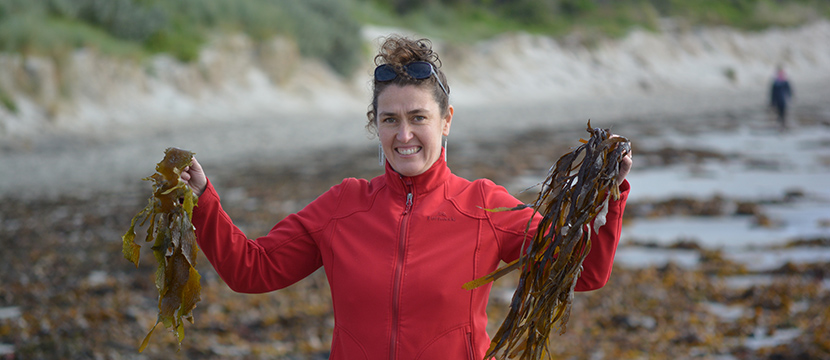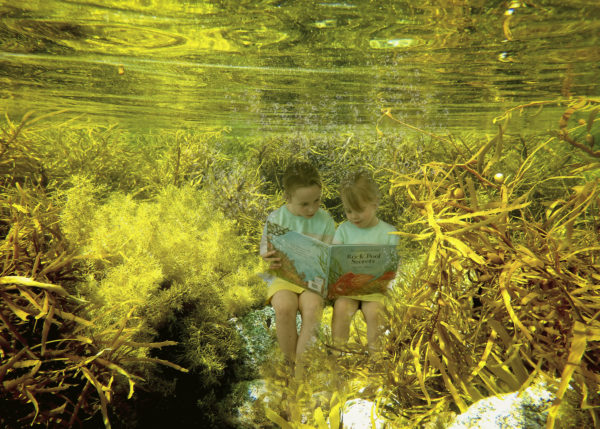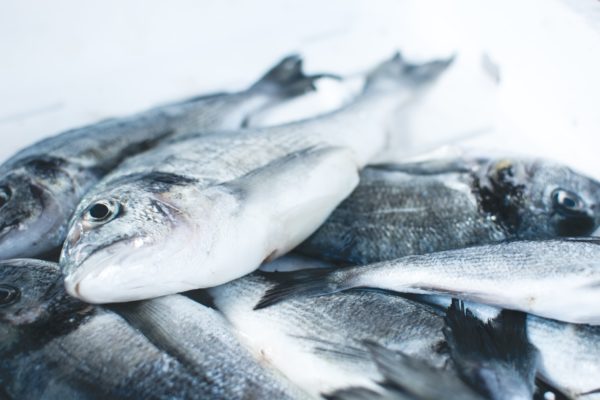“The lungs of the earth and a national treasure.” Is Dr Alecia Bellgrove really talking about the brown, slimy stuff left on the sand after high tide?
In Australia, they’re most often associated with sushi or something that spoils a nice day at the beach, but Deakin University’s Dr Alecia Bellgrove is on a mission to help us realise the potential seaweeds hold for a range of industries, from food to fibre.
Dr Bellgrove’s story is the second in Invenio’s series of profiles showcasing the people behind Deakin’s research and uncovering what drives them to make a difference to the world.
From medical breakthroughs, to developing world-first technology, to discovering new ways to help protect the environment, to building understanding between different cultures, Deakin’s researchers are creating innovative solutions to real-life issues facing our world.
Every one of them has a story to tell, and each month we’ll bring you that story in their own words.
Who is Dr Alecia Bellgrove?
Senior Lecturer in Marine Biology and Ecology with Deakin’s School of Life and Environmental Sciences at the University’s Warrnambool campus, Dr Bellgrove is a marine ecologist with both botanical and zoological training. Her research focuses on the role of habitat-forming seaweeds in ecological systems, their life history dynamics and the impacts of anthropogenic disturbances such as sewage effluent and climate change.
After completing her PhD, Dr Bellgrove spent three years in post-doctoral research at the University of Tsukuba’s Shimoda Marine Research Centre in Japan, investigating the dispersal stages of seaweeds and the basic biology behind their complex lifestyles.
A self-confessed “foodie,” in recent years Dr Bellgrove has used her knowledge of the biology and ecology of seaweeds to explore the potential of south-eastern Australia’s unique and diverse temperate marine flora as delicious and nutritious food.
In 2013, she led a crowdfunding project, “Would you like seaweed with that?” to raise funds for a research project to compare the taste of Victorian seaweeds with seaweed from other parts of the world. The results showed Australian seaweeds tested positively from both nutritional and taste perspectives.
Her work takes place in some of the most beautiful, and most foul, places on earth – from rocky reefs to sewage outlets – in the lab, and in her own kitchen with her family as test subjects.
Dr Bellgrove recently shared her insights with Professor Tim Flannery on an episode of ABC TV’s “Catalyst” program, “Can seaweed save the world?”
In her own words…
Of all the things you could research as a marine ecologist, why seaweeds?
There was a lot of research into the biology of seaweeds, but not a lot was known about how they functioned in ecosystems and how human actions might influence seaweeds and the ecosystems they support. Marine ecologists who were zoology trained were looking at seaweeds as food or habitat, but there are a lot of other roles they play in ecosystems that weren’t always considered. I thought somebody needed to be looking at it from the viewpoint of the seaweeds and asking questions in a seaweed-centric way, rather than an animal-centric way.
Unless we can understand the special dynamics of how these plants proliferate into new areas and replenish their populations, it’s difficult to gauge the impacts various influences such as global warming, increasing sea surface temperatures and changing ocean current systems might have on them.
I’m particularly interested in habitat-forming seaweeds and the role humans play in changing those natural systems. For example, if we’re harvesting seaweed for food or other uses, how much can we take without upsetting the balance and the roles seaweeds play in the natural ecosystem? How much waste water can we pump into the environment without affecting the structure of the seaweed assemblage, and what flow-on effects does that have on reef diversity?
What’s so special about seaweeds?
They are essentially the lungs of the earth. As photosynthesising plants, seaweeds produce the oxygen that we breathe, and nearly two thirds of all oxygen on earth is produced in the oceans by seaweeds, microalgae and other aquatic plants such as seagrasses. Seaweeds are not only incredibly important on a global scale for the oxygenation of the atmosphere, but they’re also the foundation of most food webs.
Most people don’t interact with seaweeds when the plants are in their prime; they see them at the tail end of their life when they’re causing a problem, but they are really beautiful when you look at them under the ocean – and when you look at them under the microscope, they’re just spectacular.
I think Australians’ main association with seaweed is the stinking, slimy mess that gets washed up on the beach, particularly around southern Australia where we have such an enormous bio-mass of seaweed on our coastal reefs. A lot of that ends up near and on the shore and it becomes a problem for people when they are trying to play in the ocean. And you know, when seaweed is at that stage it is revolting and it does get in the way of having a nice time at the beach, but you only have to stick your head under water with a mask and snorkel on and swim around with some of the seaweeds on our reefs to pretty quickly transform revulsion to fascination.
How did your focus expand to include researching seaweeds as food?
When I was living and working in Japan, I started eating seaweeds and getting interested in the ways they could be used in food. I’m a bit of a foodie in general, so when I got back to Australia I was interested in exploring Australian seaweeds for potentially edible species.
Most people’s perception of seaweeds as food is still primarily the nori sheets that are wrapped around sushi. They are just eating that one species and have very little exposure to other possibilities in Australia.
When the call came for Pozible crowdfunding projects that might capture public attention, I thought, ‘Let’s give it a go’. I really didn’t expect the uptake from the public that we received then, and since. I expected more, ‘Ewww, seaweed, that stinky, yucky stuff,’ but it’s actually been overwhelmingly the opposite. Most people have been incredibly excited by the possibilities of seaweed.
We have the highest biodiversity of seaweeds in any region in the world in south-eastern Australia, and around 60 per cent of them are endemic, which means they don’t occur anywhere else on earth. This is a really exciting opportunity to look into that flora, to try to understand what’s out there that’s potentially great to eat but also, more importantly, nutritionally rich and – equally importantly – a sustainable source of food into the future.
We don’t have enough food to feed the world and I seriously believe that greater consumption of seaweed can improve the amount of good nutritional food available in the future, help secure our food resources and improve the health outcomes of developed nations, which are suffering from diseases resulting from chronic overconsumption of poor-quality foods.
Is researching seaweeds as food particularly timely, given our current fascination with new ingredients and all things cooking?
It’s absolutely in the timing. Around the world, eating seaweeds is not a new thing but the potential for an Australian food industry based around harvesting seaweeds hasn’t been fully explored until relatively recently. Now it’s being popularised by the foodie culture and gourmet chefs, but in most cases it’s still only a garnish or a side dish, not a main player. I think we need to work out a way to make high levels of consumption realistic for the general population to be able to really reap the sustainability and nutritional benefits that come from producing and eating seaweed.
Seaweed is potentially one of the most sustainable food sources that we can grow, given that it doesn’t use any fresh water, doesn’t compete with other land uses and doesn’t require additional nutrients. Most importantly, it’s very nutritionally rich and can improve our health outcomes. However, we need to be able to eat a certain amount of it to reap the health benefits, and at the moment we’re still trying to work out ways to mainstream it beyond sushi.
Do you cook with seaweeds at home?
We do. My husband, Masaru, is Japanese and – conveniently – he’s a cook. Generally, when we eat seaweed it’s in Japanese-style cuisine. Over the past few years, since I started this research into seaweeds as food, we’ve also been experimenting with trying to incorporate seaweeds into more mainstream Australian cuisine.
I put it in salads and I’ve been experimenting with it in soups. The Japanese make a ‘dashi,’ which is essentially a soup stock, from seaweed, so we’ve been exploring some of our Australian seaweeds for good dashi production. A number of our species produce a really good stock that can then be the foundation for all sorts of things like casseroles, pasta sauce and shepherd’s pie. You can pretty much throw a bit of seaweed into all sorts of dishes without even knowing it’s there.
Seaweeds are very rich in trace minerals and there are good arguments from a nutritional perspective to increase their consumption, but in order to do that we need to work out a way for people who may be less accustomed to eating Asian foods to incorporate them into their diet. It’s still a work in progress for us, but so far we’ve incorporated seaweeds into homemade pasta and baked products, such as muffins and bread.
The flavour varies a lot between species, as does the texture and nutritional content. That’s another part of my research – trying to understand not only what the tastiest species are, but also the most nutritious. But at the end of the day, as with all things, variety is the spice of life so incorporating as many different kinds of seaweeds as possible into your diet is probably the best ticket.
What’s next?
Essentially, the crowdfunding project launched a new research area for us. I’m still involved in the research stream looking at the ecology of habitat forming seaweeds, but now there’s also this other research stream where I’m driving the potential for a sustainable seaweed industry in Australia.
I’ve got a couple of PhD students working on aspects of this project, and a couple more hopefully in the pipeline to start in this coming year, and we have small-scale industry funding that we’re hoping will grow in the future.
Global seaweed production from aquaculture has more than doubled in the past ten years and there’s an increasing public interest, but Australian industry is also seeing the potential in seaweed farming for food and other products.
There are range of compounds with gelling applications extracted from seaweeds, such as agar and carrageenan (an ingredient found in many foods, including most icecreams), but most of the seaweeds used are Northern Hemisphere species. We’re interested in finding out which of our Australian species can do the same jobs.
Most commercially farmed seaweed is used for human consumption, but there is a whole suite of other potential innovative products that can be developed as well. I’m working with a team from Deakin’s Institute for Frontier Materials (IFM) to look at the potential for developing fibres from alginate in brown seaweed. This can be used for creating wound dressings, but also potentially for scaffolding tissue implants. There is also work being done on developing fibres for textiles that incorporate the anti-bacterial properties and fire-retardant properties of seaweeds.
We’re also working with Deakin’s Institute of Koorie Education to gain a better understanding of historical and contemporary Indigenous uses of seaweeds. This not only values the ecological knowledge of the Australian Aboriginal population, but also helps to inform sustainable practices and species selection and, ideally, will develop business opportunities for coastal Indigenous populations.
What’s the best thing about your job?
I love the possibility that we could actually make a difference to the way we go about living our lives and the impact we have on the earth. What motivates me is the potential for increasing sustainable food production and the health benefits and nutritional outcomes for our population.
I’m very concerned about the levels of obesity, heart disease and associated health problems that arise from over-consumption of poor quality food. I think it’s particularly concerning when we look at our children and the increasing rates of health problems associated with obesity, in particular. I truly believe that seaweeds can play a role in helping to curb that, but there are not-trivial obstacles to trying to work out ways to make that happen. It’s an exciting space to be in.
And if you weren’t too busy researching seaweeds, what would you do instead?
I think I’d be running a sustainable food restaurant with my husband, with a nice kitchen garden and organic produce and trying to make great food in an ecologically and ethically sustainable way.
Published by Deakin Research on 28 September 2017






